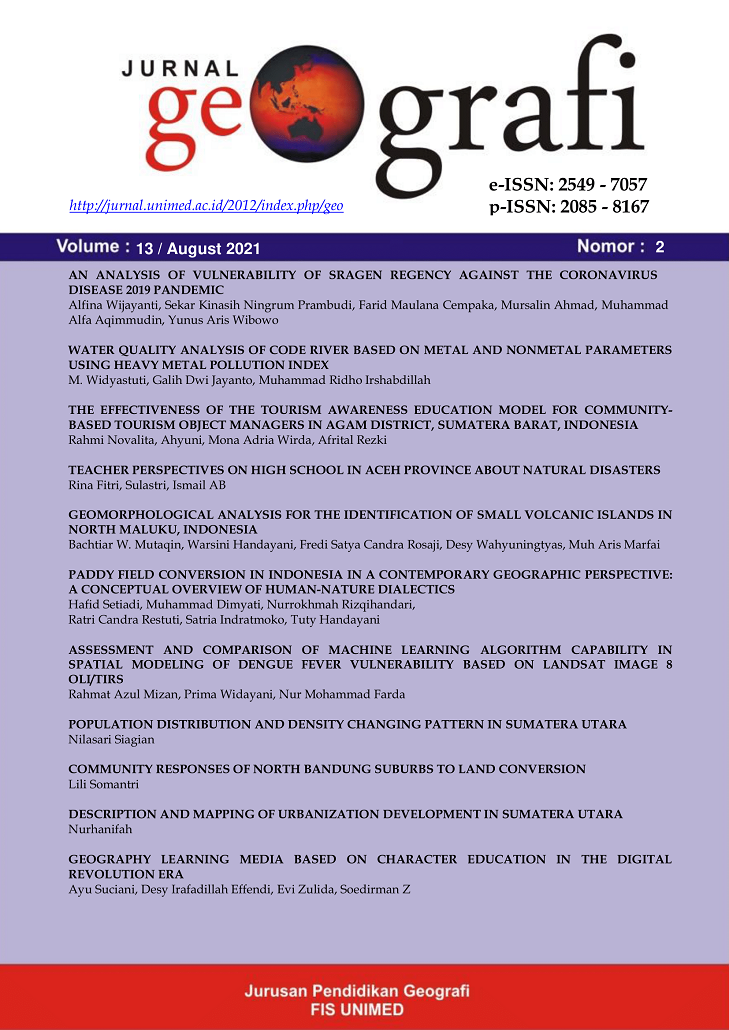AN ANALYSIS OF VULNERABILITY OF SRAGEN REGENCY AGAINST THE CORONAVIRUS DISEASE 2019 PANDEMIC
DOI:
https://doi.org/10.24114/jg.v13i2.19182Abstract
In early 2020, WHO stated that Coronavirus Disease 2019 (Covid-19) is a new type of coronavirus with high transmission and fatality. Indonesia is one of the countries exposed to Covid-19, where there has been a fluctuation in the number of victims exposed to Covid-19 since March 2020. Sragen Regency is one of the areas affected by Covid-19. This study aims to determine the level of vulnerability of the Sragen Regency to the Covid-19 pandemic and analyze the relationship between regional vulnerability and the number of Covid-19 cases (suspect, probable, confirmed, and discarded cases) in Sragen Regency. This research was conducted quantitatively by descriptive and inferential statistical analysis using the Spearman Rho test, preceded by tests of normality and homogeneity as a prerequisite test. The results indicated that the vulnerability of the Sragen Regency to Covid-19 was classified into high, medium, and low classes. High class dominated in 11 districts, medium class in 8 districts, and low class in 1 sub-district. Furthermore, the Spearman's rho test results were 0.084>0.05, which means that there was a relationship between the regional vulnerability variable and the number of Covid-19 cases, but it was not significant. That is because of the effective handling of the Covid-19 pandemic and the high level of community awareness in the Sragen Regency.Keywords: Covid-19, Disaster, Pandemic, Regional Vulnerability, SragenReferences
Adekunle, I. A., Onanuga, A. T., Akinola, O. O., & Ogunbanjo, O. W. (2020). Modelling Spatial Variations of Coronavirus Disease (COVID-19) in Africa. Science of the Total Environment, 729, 138998.
Amram, O., Amiri, S., Lutz, R. B., Rajan, B., & Monsivais, P. (2020). Development of a vulnerability index for diagnosis with the novel coronavirus, COVID-19, in Washington State, USA. Health and Place, 64, 102377.
Beaunoyer, E., & Dup, S. (2020). Computers in Human Behavior COVID-19 and digital inequalities : Reciprocal impacts and mitigation strategies. 111(April).
Chatterjee, R., Bajwa, S., Dwivedi, D., Kanji, R., Ahammed, M., & Shaw, R. (2020). COVID-19 Risk Assessment Tool: Dual application of risk communication and risk governance. Progress in Disaster Science, 7, 100109.
Djalante, R., Lassa, J., Setiamarga, D., Sudjatma, A., Indrawan, M., Haryanto, B., Mahfud, C., Sinapoy, M. S., Djalante, S., Rafliana, I., Gunawan, L. A., Surtiari, G. A. K., & Warsilah, H. (2020). Review and analysis of current responses to COVID-19 in Indonesia: Period of January to March 2020. Progress in Disaster Science, 6, 100091.
Franch-Pardo, I., Napoletano, B. M., Rosete-Verges, F., & Billa, L. (2020). Spatial analysis and GIS in the study of COVID-19. A review. Science of the Total Environment, 739, 140033.
Ghosh, K., Sengupta, N., Manna, D., & De, S. K. (2020). Inter-state transmission potential and vulnerability of COVID-19 in India. Progress in Disaster Science, 7(May), 100114.
Glover, R. E., van Schalkwyk, M. C., Akl, E. A., Kristjannson, E., Lotfi, T., Petkovic, J., Petticrew, M. P., Pottie, K., Tugwell, P., & Welch, V. (2020). A framework for identifying and mitigating the equity harms of COVID-19 policy interventions. Journal of Clinical Epidemiology.
Hamid, S., Mir, M. Y., & Rohela, G. K. (2020). Novel coronavirus disease (COVID-19): a pandemic (epidemiology, pathogenesis and potential therapeutics). New Microbes and New Infections, 35, 100679. https://doi.org/10.1016/j.nmni.2020.100679
Hardati, P. (2016). Hierarki Pusat Pelayanan Di Kecamatan Ungaran Barat Dan Ungaran Timur Kabupaten Semarang. Jurnal Geografi, 13(2), 204“215.
Karasneh, R., Al-Azzam, S., Muflih, S., Soudah, O., Hawamdeh, S., & Khader, Y. (2020). Media™s effect on shaping knowledge, awareness risk perceptions and communication practices of pandemic COVID-19 among pharmacists. Research in Social and Administrative Pharmacy, April.
Karaye, I. M., & Horney, J. A. (2020). The Impact of Social Vulnerability on COVID-19 in the U.S.: An Analysis of Spatially Varying Relationships. American Journal of Preventive Medicine, 59(3), 317“325. https://doi.org/10.1016/j.amepre.2020.06.006
Khan, M. N., Islam, M. M., & Rahman, M. M. (2020). Risks of COVID19 outbreaks in Rohingya refugee camps in Bangladesh. Public Health in Practice, 1(June), 100018.
Lakhani, A., & Lecturer, S. (2020). Which Melbourne metropolitan areas are vulnerable to COVID-19 based on age, disability and access to health services? Using spatial analysis to identify service gaps and inform delivery. Journal of Pain and Symptom Management.
Lee, A., & Morling, J. (2020). COVID19: The need for public health in a time of emergency. Public Health, 182, 188“189.
Lescanne, E., van der Mee-Marquet, N., Juvanon, J. M., Abbas, A., Morel, N., Klein, J. M., Hanau, M., & Couloigner, V. (2020). Best practice recommendations: ENT consultations during the COVID-19 pandemic. European Annals of Otorhinolaryngology, Head and Neck Diseases, 137(4), 303“308.
Lin, Q., Zhao, S., Gao, D., Lou, Y., Yang, S., Musa, S. S., Wang, M. H., Cai, Y., Wang, W., Yang, L., & He, D. (2020). A conceptual model for the coronavirus disease 2019 (COVID-19) outbreak in Wuhan, China with individual reaction and governmental action. International Journal of Infectious Diseases, 93, 211“216.
McBryde, E. S., Meehan, M. T., Adegboye, O. A., Adekunle, A. I., Caldwell, J. M., Pak, A., Rojas, D. P., Williams, B., & Trauer, J. M. (2020). Role of modelling in COVID-19 policy development. Paediatric Respiratory Reviews.
Mustafa, N. M., & A Selim, L. (2020). Characterisation of COVID-19 Pandemic in Paediatric Age Group: A Systematic Review and Meta-Analysis. Journal of Clinical Virology, 128(April), 104395.
























